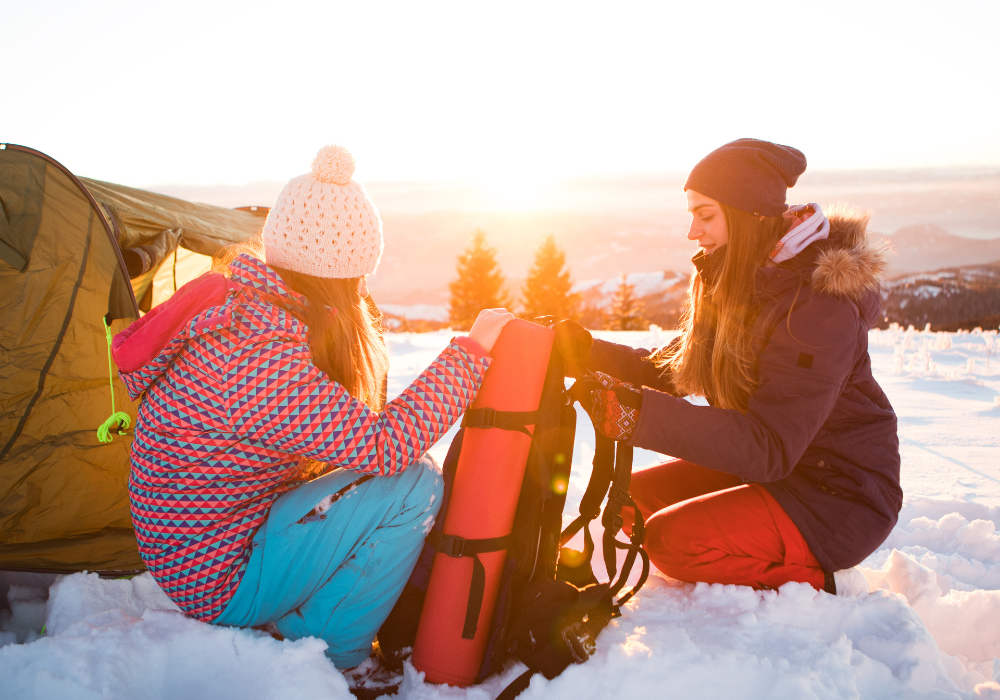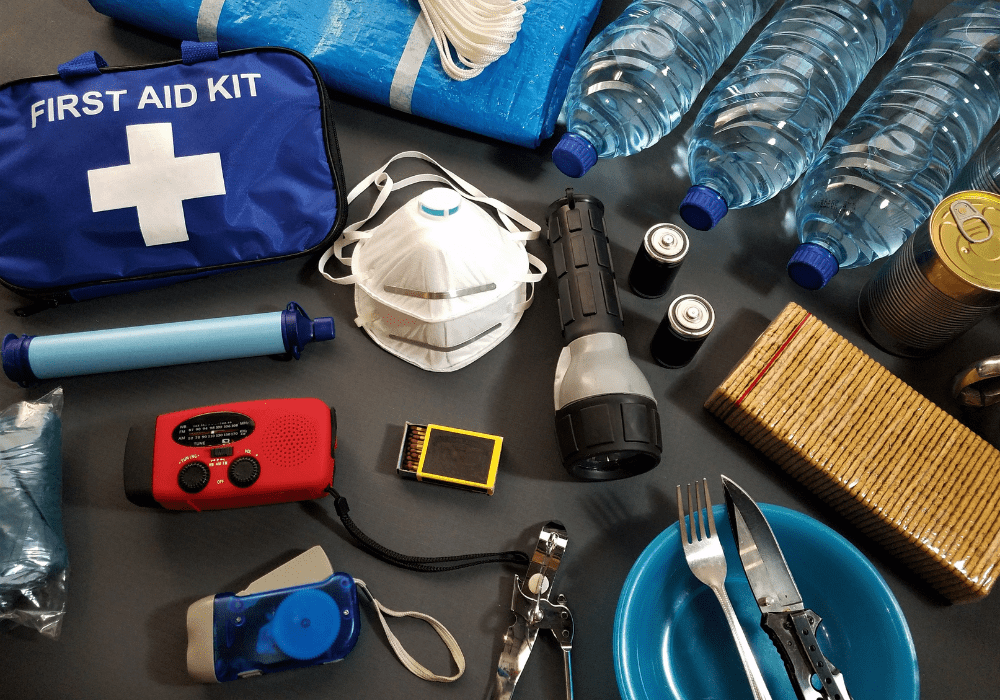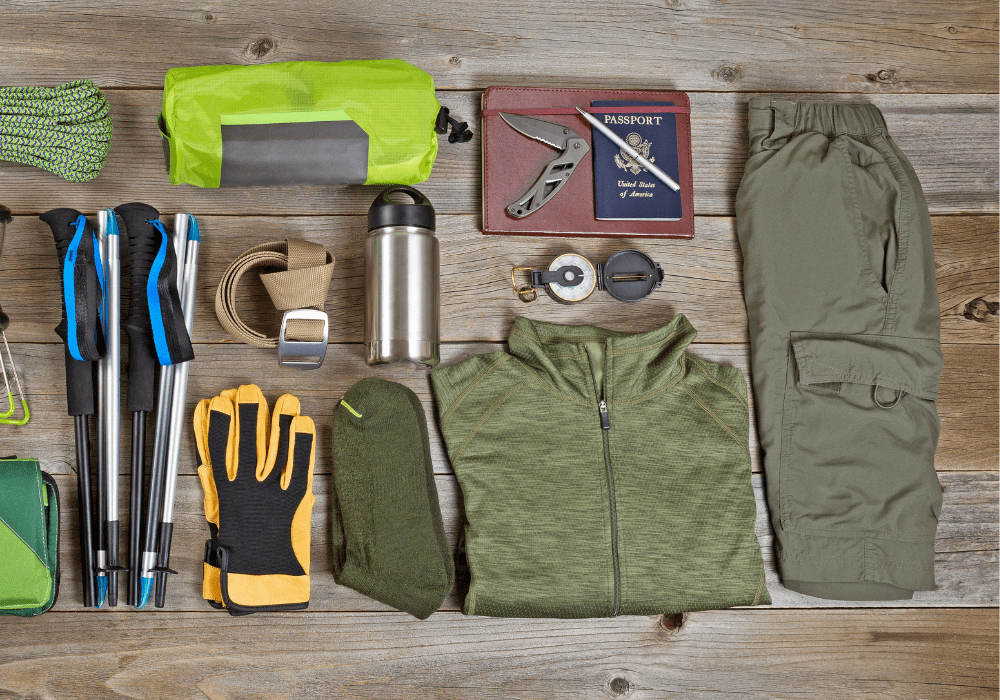
Winter Camping Essential Gear Checklist
Among the four seasons, winter brings the most challenges.
Depending on where you are, winter’s extreme cold can come with frequent rains, dense snowfall, freezing winds, and a lack of vegetation. These obstacles are enough to keep most people indoors, waiting for spring to arrive.
However:
To us, camping enthusiasts, winter’s unique challenges also present opportunities for unique experiences.
Table of Contents
Enjoy Winter With These Essential Camping Gear
If you’re looking to do some winter camping, then this article is for you. Here you’ll find our list of winter camping essentials. At the bottom, we also included an easy-to-print quick checklist of all the items you see here.
1. Layers of Clothes
You need to insulate yourself against the cold by wearing multiple layers of clothes.
Wearing multiple layers not only keeps you warm but also lets you adjust your level of insulation by taking off or putting on more layers. Clothes layering applies not just to your upper body but to your lower body and extremities as well.
For both your upper and lower body, your first layer should always be something warm (like wool). Your final layer should be something waterproof that can also protect you from chilling winds.
2. Boots
Your ordinary camping footwear may not be sufficient for the rigors of wintertime. While snow is more gentle to walk on than solid ground, you run the danger of having water seep through your shoes which can eventually cause frostbite.
You can avoid this by switching to winter boots.
Ideally, your winter camping boots must be durable, insulating, waterproof, have good traction, and compatible with snowshoes and crampons.
3. Gaiters
You can wear multiple layers of pants and the best winter boots money can buy but you may be surprised to find that somehow your feet are still getting soaked and cold.
What gives?
It may be due to the snow and water entering through the side of your lower legs and into your boots. You can avoid this by wearing winter gaiters. Winter gaiters don’t only shield your feet from snow and water but also dirt, grit, and other debris.
4. Hat
A winter hat shields your face from sunlight but, more importantly, also keeps heat from escaping through your head. There are plenty of designs to choose from but make sure you pick something insulating, sweat-wicking, and quick-drying.
5. Balaclava
There may be times when it’s so cold that your face starts to hurt and turn blue. You can protect your face from chilling winds, snow, and rain by wearing a balaclava or ski mask. This item is especially helpful for keeping you warm and toasty during bedtime.
6. Sunglasses
If you’ve ever caught yourself squinting when looking across a field of snow then you know how reflective snow can be.
Snow reflects 90% of sunlight so it’s important to wear polarized sunglasses to protect your eyes. Polarized sunglasses also come with the benefit of preventing premature wrinkling around the eyes, which is always a plus.
7. Emergency Food and Water Bottle
Whether you plan to bring food or do a catch-and-cook, you need to bring emergency rations of food and water in case you’ll need them.
Contrary to popular belief, winter doesn’t make our bodies consume more calories so you can bring what you normally do for camping during the rest of the year.
That said, you have to keep your water in an insulated bottle or vacuum thermos to keep it from freezing. If you don’t have either of the two, you can get away with an ordinary plastic water bottle as long as you keep it in your shirt, as close to your body as possible.
8. Headlamp
If you plan to camp overnight, you’ll need a source of light. This is especially true for winter camping since we get shorter days and longer nights during this season.
A flashlight or lantern will do but if you want to have both hands free for carrying stuff or doing chores, you’ll need a headlamp – preferably one with a signaling mode.
9. Tent or Tarp
Of course, we can’t talk about camping without mentioning shelter.
For winter camping, you’ll want a balance between durability, weight, and insulation. If you’re camping somewhere where it never snows, you can get away with a tarp instead of a tent. It should go without mentioning that your tent or tarp has to be waterproof.
10. Winter Sleeping Bag and Pad
If you think camping overnight without a sleeping bag is cold, you may not want to try doing it during wintertime.
A winter sleeping bag keeps you warm and toasty while you sleep. Make sure you’re getting one with a balance of insulating features and comfort.
Speaking of insulation and comfort, there’s no better time to use a sleeping pad than winter camping. A sleeping pad not only dampens protrusions from the ground but also shields you from its freezing temperature.
11. Firestarter
The ability to start a fire easily is important while camping, especially in the cold winter. Whether it’s a lighter, matches (ordinary or all-weather), flint and steel, or a Ferro rod, make sure you keep them somewhere accessible and secure.
12. Trekking Pole
A trekking pole is most useful when you’re hiking to (or looking for) your camping spot. It warns you of terrain dangers beforehand, provides support, and can be used as a weapon to ward off animals.
At camp, you can also use your trekking pole as a post for your tarp shelter.
13. Tools
It’s always handy to have the right tool for the right job. However, since we can only carry so much in our backpacks, we need to carry only the most versatile tools to camp.
Through experience, we can say that you can solve most problems with either a survival knife, an E-tool, a multi-tool, or some 550 paracord.
That said:
You’re going to need more wood to stave off the winter cold so it’s a great idea to include a folding bow saw among your camping tools. A folding bow saw lets you cut larger branches (and even logs) while still being easy to store and carry.
While we normally recommend duct tape as a necessity, we suggest leaving it at home when winter camping as the adhesive on duct tape doesn’t work well in the cold.
14. Cooler
While you may not need to keep your food cool during winter, a cooler is still a good way to keep your food clean and away from pests and animals. Having a cooler also lets you store any food you catch or forage before you cook it.
15. Camping Stove and Cookware
Unless you’re planning to eat meals you’ve prepared beforehand, you’ll need a camping stove to cook or heat your food, boil water, or melt snow for drinking water.
You may want to bring a camping stove that comes with a metal windshield to keep your fire burning on windy days.
It should go without mentioning that you’ll need to bring a camping pot and/or pan to cook your food in.
16. First Aid Kit with Space Blanket
You never know what emergencies you have to face at camp. It’s always a great idea to bring a fully-stocked first aid kit that includes a space blanket.
17. Toiletries and Personal Hygiene Products
Remember to carry toilet paper for when you need to answer nature’s call. You’ll also need to bring personal hygiene products (like soap and toothpaste) especially if you’re camping for several days.
18. Bin Bags
As responsible campers, we need to leave without a trace. Be sure to clean up your campsite before leaving.
Winter Camping Essentials Quick Checklist
Don’t go winter camping without these:
- Layers of Clothes
- Boots
- Gaiters
- Hat
- Balaclava
- Sunglasses
- Emergency Food and Water Bottle
- Headlamp
- Tent or Tarp
- Winter Sleeping Bag and Pad
- Firestarter
- Trekking Pole
- Tools
- Cooler
- Camping Stove and Cookware
- First Aid Kit with Space Blanket
- Toiletries and Personal Hygiene Products
- Bin Bags




